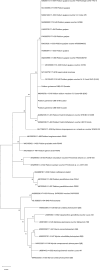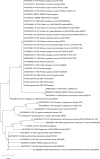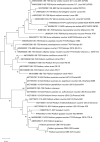DNA Barcode, chemical analysis, and antioxidant activity of Psidium guineense from Ecuador
- PMID: 40106513
- PMCID: PMC11922285
- DOI: 10.1371/journal.pone.0319524
DNA Barcode, chemical analysis, and antioxidant activity of Psidium guineense from Ecuador
Erratum in
-
Correction: DNA Barcode, chemical analysis, and antioxidant activity of Psidium guineense from Ecuador.PLoS One. 2025 Jun 5;20(6):e0326074. doi: 10.1371/journal.pone.0326074. eCollection 2025. PLoS One. 2025. PMID: 40472314 Free PMC article.
Abstract
This study investigates the phytochemical, genetic, and antioxidant properties of Psidium guineense, a species native to the tropical dry forests of Ecuador. Leaves were collected, preserved in recognized herbaria, and subjected to Soxhlet extraction using polar and non-polar solvents. Phytochemical screening revealed the presence of secondary metabolites, while GC-MS analysis detected chemical compounds in the extracts. Antioxidant assays demonstrated high phenolic (54.34 ± 0.49 mg GAE/g) and flavonoid (6.43 ± 0.38 mg QE/g) content, with significant antioxidant activity in DPPH (0.57 ± 0.04 mg TE/g), FRAP (105.52 ± 6.85), and ABTS (1.25 ± 0.01 mg TE/g) assays. DNA barcoding of nine loci, (seven from the chloroplast genome and two nuclear genome) using a CTAB extraction protocol and PCR, provides the first genetic characterization of this species, contributing to genetic diversity assessments and phylogenetic studies. These findings underscore the importance of P. guineense as a source of potent bioactive compounds with significant antioxidant potential, highlighting its applicability in nutritional and pharmaceutical industries. Additionally, the genetic insights gained support efforts to expand DNA barcoding databases for tropical biodiversity conservation.
Copyright: © 2025 Vielma-Puente et al. This is an open access article distributed under the terms of the Creative Commons Attribution License, which permits unrestricted use, distribution, and reproduction in any medium, provided the original author and source are credited.
Conflict of interest statement
The authors have declared that no competing interests exist.
Figures





Similar articles
-
Preliminary phytochemical screening and antioxidant activity of Annona deceptrix (Westra) H. Rainer an endemic and endangered species of Ecuador.Braz J Biol. 2025 Feb 14;85:e287825. doi: 10.1590/1519-6984.287825. eCollection 2025. Braz J Biol. 2025. PMID: 39968997
-
Crystal Guava (Psidium guajava L. "Crystal"): Evaluation of In Vitro Antioxidant Capacities and Phytochemical Content.ScientificWorldJournal. 2020 Sep 1;2020:9413727. doi: 10.1155/2020/9413727. eCollection 2020. ScientificWorldJournal. 2020. PMID: 32952456 Free PMC article.
-
Chemical analysis and antioxidant, anti-inflammatory and toxicological evaluations of the hydromethanolic extract of Psidium guineense Swartz leaves.J Ethnopharmacol. 2021 Dec 5;281:114492. doi: 10.1016/j.jep.2021.114492. Epub 2021 Aug 8. J Ethnopharmacol. 2021. PMID: 34380066
-
Which Extraction Solvents and Methods Are More Effective in Terms of Chemical Composition and Biological Activity of Alceafasciculiflora from Turkey?Molecules. 2022 Aug 6;27(15):5011. doi: 10.3390/molecules27155011. Molecules. 2022. PMID: 35956963 Free PMC article. Review.
-
Effect of solvent polarity on the Ultrasound Assisted extraction and antioxidant activity of phenolic compounds from habanero pepper leaves (Capsicum chinense) and its identification by UPLC-PDA-ESI-MS/MS.Ultrason Sonochem. 2021 Aug;76:105658. doi: 10.1016/j.ultsonch.2021.105658. Epub 2021 Jul 2. Ultrason Sonochem. 2021. PMID: 34242865 Free PMC article. Review.
Cited by
-
Desmodium molliculum (Kunth) DC., an Andean medicinal plant: DNA barcoding and HPLC fingerprint for species discrimination and evaluation of its pharmacological potential.Front Plant Sci. 2025 Jul 24;16:1612556. doi: 10.3389/fpls.2025.1612556. eCollection 2025. Front Plant Sci. 2025. PMID: 40777057 Free PMC article.
-
Correction: DNA Barcode, chemical analysis, and antioxidant activity of Psidium guineense from Ecuador.PLoS One. 2025 Jun 5;20(6):e0326074. doi: 10.1371/journal.pone.0326074. eCollection 2025. PLoS One. 2025. PMID: 40472314 Free PMC article.
References
-
- Mittermeier RA, Turner WR, Larsen FW, Brooks TM, Gascon C. Global Biodiversity Conservation: The Critical Role of Hotspots. Biodiversity Hotspots. Springer Berlin Heidelberg; 2011. pp. 3–22. doi: 10.1007/978-3-642-20992-5_1 - DOI
-
- Kleemann J, Koo H, Hensen I, Mendieta-Leiva G, Kahnt B, Kurze C, et al.. Priorities of action and research for the protection of biodiversity and ecosystem services in continental Ecuador. Biological Conservation. 2022;265:109404. doi: 10.1016/j.biocon.2021.109404 - DOI
-
- Cuesta F, Peralvo M, Merino-Viteri A, Bustamante M, Baquero F, Freile JF, et al.. Priority areas for biodiversity conservation in mainland Ecuador. Neotropical Biodiversity. 2017;3(1):93–106. doi: 10.1080/23766808.2017.1295705 - DOI
-
- Nybg, Herbarium S. No Title. 2016. Available from: http://sweetgum.nybg.org/science/vh/specimen-details/?irn=3156114
MeSH terms
Substances
LinkOut - more resources
Full Text Sources
Medical
Miscellaneous

